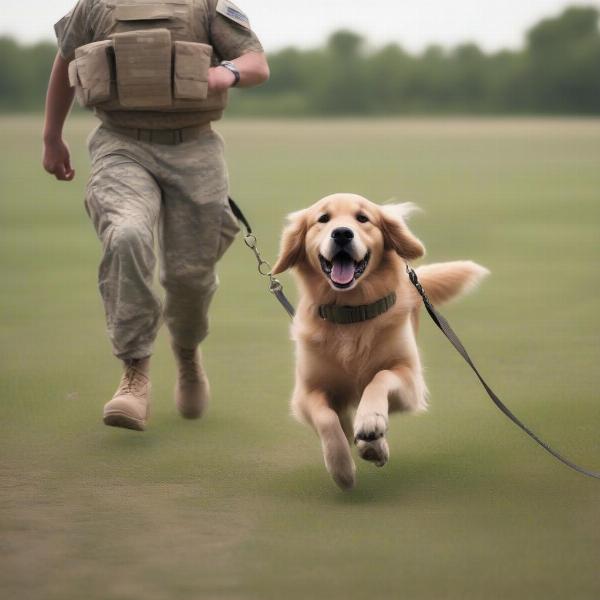Military commands offer a structured and effective way to train your dog, fostering clear communication and a strong bond. Whether you’re a seasoned dog owner or just starting out, understanding and implementing these commands can significantly enhance your training experience. This guide delves into the world of military dog commands, exploring their benefits, providing step-by-step instructions, and addressing common challenges.
The Power of Military Commands for Dogs
Military commands are renowned for their precision and clarity. This distinct advantage translates seamlessly into dog training, providing a consistent language that your dog can readily understand. These commands minimize confusion, ensuring that your instructions are unambiguous. The structured nature of military commands also establishes a framework for learning, making training sessions more efficient and productive. Furthermore, these commands can help build a stronger bond between you and your dog, based on mutual respect and understanding.
Essential Military Commands for Your Dog
Let’s explore some fundamental military commands and how to teach them effectively:
Heel
The “Heel” command teaches your dog to walk politely by your side, maintaining a consistent position without pulling or lagging. Start by holding a treat near your dog’s nose, walk forward, and use the command “Heel”. Reward your dog for staying by your side. Gradually increase the distance and duration as your dog progresses.
Sit
“Sit” is a basic command that teaches your dog to sit on cue. Hold a treat above your dog’s head, move it towards their tail, and say “Sit”. As their rear touches the ground, reward them. Practice this repeatedly until your dog responds reliably to the verbal command.
Stay
The “Stay” command is crucial for safety and control. After your dog is sitting, hold your hand up in a stop motion and say “Stay”. Initially, start with short durations and gradually increase the time. Reward your dog for remaining in the stay position.
Down
“Down” instructs your dog to lie down. Lure your dog down with a treat, moving it towards the ground while saying “Down”. Reward them when they lie down. Consistent practice will reinforce this command.
Come
The “Come” command is vital for recall. Use a cheerful tone and say “Come” while backing away. Reward your dog enthusiastically when they come to you. Practice in various environments to ensure reliability.
 Dog running towards handler on "Come" command
Dog running towards handler on "Come" command
Expert Insights on Military Commands
Dr. Emily Carter, a certified canine behaviorist, emphasizes the importance of consistency in training: “Using military commands consistently helps dogs understand expectations clearly. It establishes a framework for predictable communication.” Similarly, John Miller, a professional dog trainer with years of experience working with military dogs, adds: “The clarity of military commands eliminates ambiguity, creating a learning environment that fosters quick and reliable responses in dogs.”
Troubleshooting Common Challenges
Some dogs may initially struggle with certain commands. Patience and positive reinforcement are key. Break down commands into smaller steps, reward even minor successes, and avoid punishment.
Conclusion
Mastering military commands for dogs offers significant benefits, from improved communication to enhanced safety and control. By following the steps outlined in this guide, you can effectively teach your dog these valuable commands, building a stronger bond and enriching your relationship.
FAQ
- Are military commands too harsh for dogs? No, when used with positive reinforcement, they provide clear communication.
- How long does it take to teach military commands? It varies depending on the dog and consistency of training.
- Can any dog learn military commands? Yes, dogs of all breeds and ages can learn these commands.
- What if my dog doesn’t respond to a command? Break down the command into smaller steps and use positive reinforcement.
- Are there any other helpful resources for training? Consult a certified dog trainer or behaviorist for personalized guidance.
- Can I adapt military commands for my dog’s specific needs? Yes, you can tailor the training approach to suit your dog’s individual personality and learning style.
- Is it essential to use the exact wording of military commands? Consistency is key, but minor variations are acceptable as long as they are clear and consistent.
Related Articles
About ILM Dog
ILM Dog is your trusted global resource for expert canine care and nurturing advice. We offer comprehensive information on dog breeds, health, training, nutrition, grooming, and much more, catering to both novice and experienced dog owners. Whether you’re looking to understand the nuances of a specific breed like the eastern shepherd dog or need advice on dog-friendly policies, like those at Academy which you can find in our article is academy dog friendly, ILM Dog has you covered. Contact us for personalized support and guidance: [email protected] or +44 20-3965-8624.